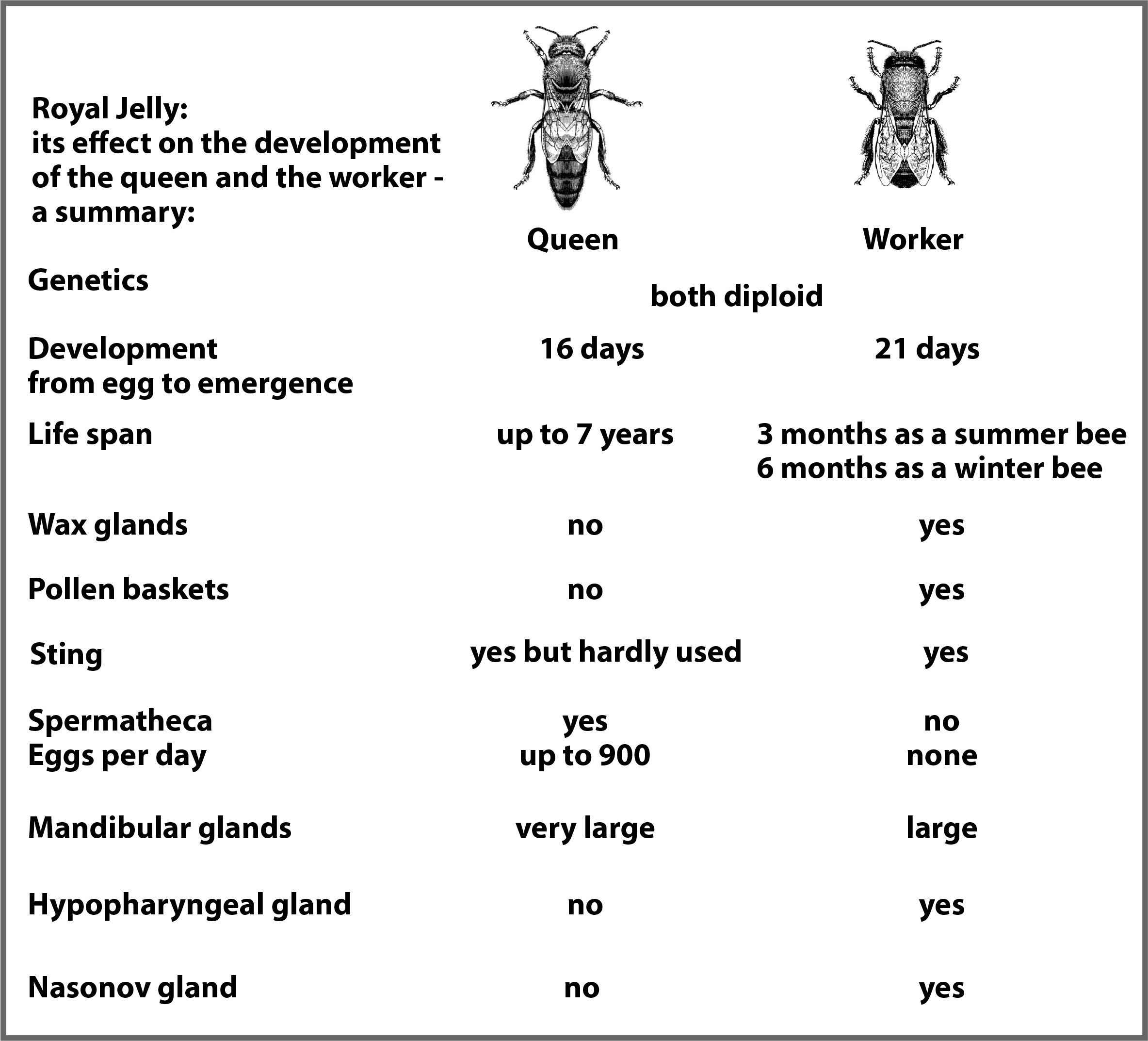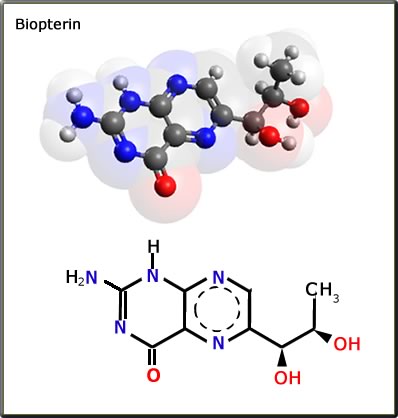
Brood 5: Brood Food
Royal Jelly - Brood food constituents
10-Hydroxy-2-decenoic acid
Sometimes called queen bee acid has been implicated to be involved in the longer lifespan of queens in contrast to workers. It is only found in royal jelly; nowhere else in the hive.
Sometimes called queen bee acid has been implicated to be involved in the longer lifespan of queens in contrast to workers. It is only found in royal jelly; nowhere else in the hive.
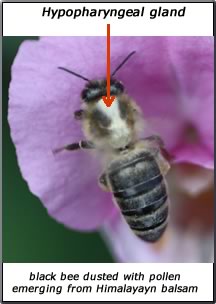
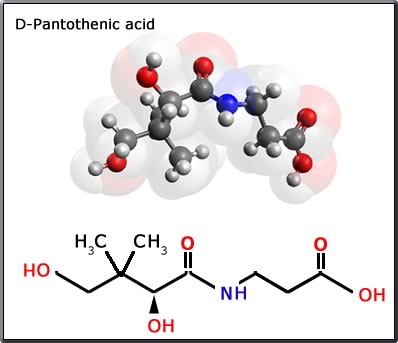
-10-Hydroxy-2-decenoic acid.jpg)
Biopterin
is a chemical rich in nitrogen synthesized by the bees.
It functions as a co-enzyme for a number of enzyme catalyzed reactions. As such biopterin can be regarded as a helper molecule; it binds loosely with an enzyme to initiate or aid the function of the enzyme at the active site.
is a chemical rich in nitrogen synthesized by the bees.
It functions as a co-enzyme for a number of enzyme catalyzed reactions. As such biopterin can be regarded as a helper molecule; it binds loosely with an enzyme to initiate or aid the function of the enzyme at the active site.
Pantothenic acid
Pantothenic acid, also called vitamin B5, is a water-soluble vitamin.
Pantothenic acid is an essential nutrient; it is used by animals in order to synthesize coenzyme-A (CoA), as well as to synthesize and metabolize proteins, carbohydrates, and fats.
Pantothenic acid, also called vitamin B5, is a water-soluble vitamin.
Pantothenic acid is an essential nutrient; it is used by animals in order to synthesize coenzyme-A (CoA), as well as to synthesize and metabolize proteins, carbohydrates, and fats.
The Hypopharyngeal gland (HPG)
produces and secretes the components of royal jelly which is the most important food for brood and queen.
The HPG gland in the honey bee is a paired organ, located in the head of the worker bee, in front of the brain between the compound eyes (see photo).
HPGs start to develop in worker pupae about a week before emergence and continue after bees emerge. Active secretion reaches its peak in nurse workers at the age of 6 to 13 days thus from day 6 the bees are able to feed brood and so become nurse bees after their cleaning duties.
The gland size increases and decreases with age of the worker. Secretion occurs at the front of the mouth.
In summer the HPG is a flexible organ in young worker bees. These are able to actively respond to the needs of the colony, not only with normal brood but also with brood rearing in swarms or in queen supersedure. The HPG in foragers which have left feeding duties is able to be redeployed in an emergency so that these bees can revert to feeding brood once more.
In winter bees the HPGs are hypertrophied (increased in size) and it is assumed that the secretion is stored until spring.
produces and secretes the components of royal jelly which is the most important food for brood and queen.
The HPG gland in the honey bee is a paired organ, located in the head of the worker bee, in front of the brain between the compound eyes (see photo).
HPGs start to develop in worker pupae about a week before emergence and continue after bees emerge. Active secretion reaches its peak in nurse workers at the age of 6 to 13 days thus from day 6 the bees are able to feed brood and so become nurse bees after their cleaning duties.
The gland size increases and decreases with age of the worker. Secretion occurs at the front of the mouth.
In summer the HPG is a flexible organ in young worker bees. These are able to actively respond to the needs of the colony, not only with normal brood but also with brood rearing in swarms or in queen supersedure. The HPG in foragers which have left feeding duties is able to be redeployed in an emergency so that these bees can revert to feeding brood once more.
In winter bees the HPGs are hypertrophied (increased in size) and it is assumed that the secretion is stored until spring.
Although the queen and worker are genetically identical (both diploid) the feeding of the queen larva with royal jelly induces in a young larva a series of hormonal and biochemical actions and reactions that make it develop into a queen bee. This differential rearing procedure results in striking morphological, behavioural, and physiological differences between these different castes .
As a result of this special nutrition, the queen constitute the sexual caste and has large active ovaries, whereas workers have only rudimentary, inactive ovaries and are functionally sterile.
The worker bee however develops traits that relate only to work, i.e. glands producing brood food, wax glands and pollen baskets.
10-Hydroxy-2-decenoic acid is thought to be the principle active substance in Royal Jelly; it makes the queen bee fifty percent larger than the female worker bee and gives her incredible stamina, ovulation ability and longevity, living up to 6 years longer than worker bees who only live for about 3 months.
Some importanf ccnstituents of royal jelly are shown below.
As a result of this special nutrition, the queen constitute the sexual caste and has large active ovaries, whereas workers have only rudimentary, inactive ovaries and are functionally sterile.
The worker bee however develops traits that relate only to work, i.e. glands producing brood food, wax glands and pollen baskets.
10-Hydroxy-2-decenoic acid is thought to be the principle active substance in Royal Jelly; it makes the queen bee fifty percent larger than the female worker bee and gives her incredible stamina, ovulation ability and longevity, living up to 6 years longer than worker bees who only live for about 3 months.
Some importanf ccnstituents of royal jelly are shown below.
Royal jelly is secreted from the hypopharyngeal and mandibular glands in nurse bees and fed to all larvae, worker, queen and drone, in the first 3 days. During this time a worker grub and a queen grub can be interchanged i.e. the original queen grub becomes a worker and the worker grub becomes a queen. The mandibular secretions contain a high levels of biopterin and pantothenic acid
A queen larva continues to be fed royal jelly with the grub appearing to float in the liquid. The worker larvae on the other hand are fed an 'inferior' food containing a mixture of royal jelly, pollen and nectar. The concentration of sugars mainly fructose and glucose is much higher in the food given to a queen larva.
A queen larva continues to be fed royal jelly with the grub appearing to float in the liquid. The worker larvae on the other hand are fed an 'inferior' food containing a mixture of royal jelly, pollen and nectar. The concentration of sugars mainly fructose and glucose is much higher in the food given to a queen larva.
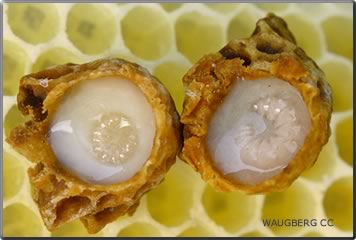
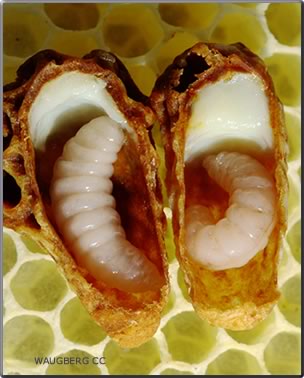
The photo (left) shows two young queen larvae floating in royal jelly.
Those on the right have just been sealed in the cell with a royal jelly reserve.
Those on the right have just been sealed in the cell with a royal jelly reserve.
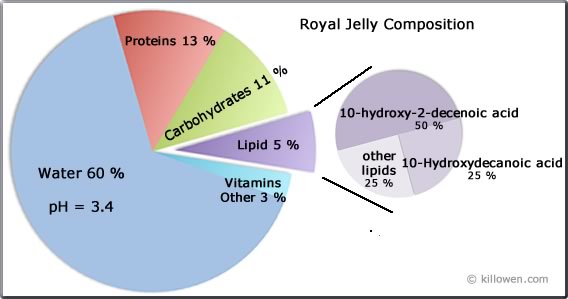
What are the constituents in royal jelly? This has been and continues to be the subject of much research.
Water: about 60%: pH = 3.4
Proteins: (about 13 %) the amino acids present in the highest percentages are proline, lysine, glutamic acid, β-alanine, phenylalanine, aspartate and serine
Carbohydrates: (about 11 %) as in honey, the monosaccharides fructose and glucose are the main sugars. They often account for over 90% of the total sugars and, of the two, fructose is prevalent. Sucrose is also present but in much smaller amounts.
Water: about 60%: pH = 3.4
Proteins: (about 13 %) the amino acids present in the highest percentages are proline, lysine, glutamic acid, β-alanine, phenylalanine, aspartate and serine
Carbohydrates: (about 11 %) as in honey, the monosaccharides fructose and glucose are the main sugars. They often account for over 90% of the total sugars and, of the two, fructose is prevalent. Sucrose is also present but in much smaller amounts.
Lipids:
(about 5 %) consists primarily of organic acids mono- and dihydroxy acids and dicarboxylic acids with 8 and 10 carbon atoms.
10-Hydroxy-2-decenoic acid (sometimes called queen bee acid) can be found in high concentrations (50%) and is the major lipid component. Its saturated analogue 10-Hydroxydecanoic acid is also found in royal jelly as the second most dominant lipid component (25%).
Minerals: (0.8 - 3 %) the major elements are, in descending order: K, Ca, Na, Mg, Zn, Fe, Cu and Mn
Vitamins: riboflavin, thiamine, niacin and folic acid, B complex and panthothenic acid,
10-Hydroxy-2-decenoic acid (sometimes called queen bee acid) can be found in high concentrations (50%) and is the major lipid component. Its saturated analogue 10-Hydroxydecanoic acid is also found in royal jelly as the second most dominant lipid component (25%).
Minerals: (0.8 - 3 %) the major elements are, in descending order: K, Ca, Na, Mg, Zn, Fe, Cu and Mn
Vitamins: riboflavin, thiamine, niacin and folic acid, B complex and panthothenic acid,
